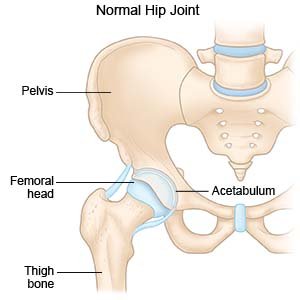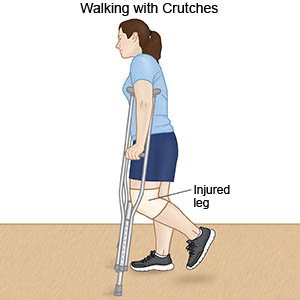Hip Impingement
Medically reviewed by Drugs.com. Last updated on Aug 4, 2025.
Hip impingement happens when tissue becomes trapped between bones of your hip joint. This causes pain when you move the hip joint or sit for long periods. Over time, osteoarthritis can develop if cartilage in the joint is damaged or worn away. Early treatment is important to help delay the development of osteoarthritis or other problems.
 |
DISCHARGE INSTRUCTIONS:
Return to the emergency department if:
- You have severe pain.
- You cannot move your joint.
Call your doctor if:
- You have a fever or chills.
- Your joint is red and tender.
- You have new or worsening symptoms.
- You have questions or concerns about your condition or care.
Medicines:
- NSAIDs , such as ibuprofen, help decrease pain and inflammation. This medicine is available with or without a doctor's order. NSAIDs can cause stomach bleeding or kidney problems in certain people. If you take blood thinner medicine, always ask your healthcare provider if NSAIDs are safe for you. Always read the medicine label and follow directions.
- Take your medicine as directed. Contact your healthcare provider if you think your medicine is not helping or if you have side effects. Tell your provider if you are allergic to any medicine. Keep a list of the medicines, vitamins, and herbs you take. Include the amounts, and when and why you take them. Bring the list or the pill bottles to follow-up visits. Carry your medicine list with you in case of an emergency.
Physical therapy
may be recommended. A physical therapist can teach you exercises to improve the strength and range of motion in your hip. Do not try to move your leg past the range of motion it has without help from a physical therapist. Too much motion can make hip impingement worse.
Manage hip impingement:
- Maintain a healthy weight. This helps decrease the strain on your hip joint. Ask your healthcare provider what a healthy weight is for you. He or she can help you create a weight loss plan if you are overweight.
- Apply heat or ice on the joint as directed. Heat and ice help decrease pain, swelling, and muscle spasms. For heat, use a heating pad on a low setting for 20 minutes, or take a warm bath. For ice, use an ice pack, or put crushed ice in a plastic bag. Cover it with a towel before you place it on your joint. Use ice for 15 minutes every hour.
- Massage the muscles around the joint. Massage helps relieve pain and stiffness. Your healthcare provider or a physical therapist can show you how to do this. Another person may need to help you massage the area.
- Use a cane, crutches, or a walker if directed. These help protect and relieve pressure on your hip joint.

- Wear flat or low-heeled shoes. This will help decrease pain and reduce pressure on your hip joint.
Follow up with your doctor as directed:
Your doctor may refer you to a specialist, such as a physical therapist or a pain specialist. Write down your questions so you remember to ask them during your visits.
© Copyright Merative 2025 Information is for End User's use only and may not be sold, redistributed or otherwise used for commercial purposes.
The above information is an educational aid only. It is not intended as medical advice for individual conditions or treatments. Talk to your doctor, nurse or pharmacist before following any medical regimen to see if it is safe and effective for you.
Further information
Always consult your healthcare provider to ensure the information displayed on this page applies to your personal circumstances.
